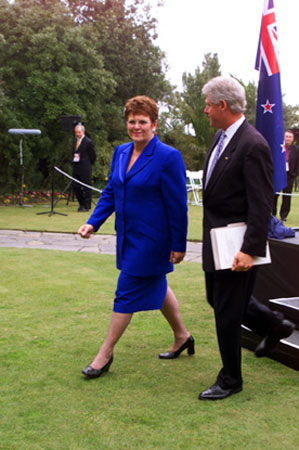- Jenny Shipley
Infobox_Officeholder
honorific-prefix =The Right Honourable
name =Jennifer Mary Shipley
honorific-suffix =
DCNZM
caption=Jenny Shipley (centre), with United States PresidentBill Clinton ,September 15 ,1999
order=36thPrime Minister of New Zealand
term_start=8 December 1997
term_end=5 December 1999
(2 years)
monarch= Elizabeth II
governor-general= Sir Michael Hardie Boys
predecessor=Jim Bolger
successor=Helen Clark
deputy=Winston Peters (1997 - 1998)Wyatt Creech (1998 - 1999)
order2 =28th Leader of the Opposition
term_start2 =5 December 1999
term_end2 =8 October 2001
predecessor2 =Helen Clark
successor2 =Bill English
birth_date=Birth date and age|1952|2|4|df=yes
birth_place=Gore, New Zealand
spouse= Burton Shipley (Married1972 )
children=Two
party=National
constituency =Ashburton, Rakaia
religion=Presbyterian
profession=TeacherJennifer Mary Shipley, DCNZM, (born
4 February 1952 ,Gore, New Zealand ), was thePrime Minister of New Zealand from December1997 to December1999 , the first woman to hold this office and the first and to date only woman to serve as leader of the National Party.Early life
She was born and christened Jennifer Mary Robson in the southern town of
Gore, New Zealand . In1971 she gained qualification as a teacher, and taught in New Zealand primary schools until1976 . She also served in a number of educational and child-care organizations, such as thePlunket Society .Member of Parliament
Having joined the National Party in
1975 , Shipley successfully stood for the Ashburton electorate in 1987 election. She would represent this electorate until her retirement from politics in2001 , though it was renamed Rakaia in1996 .Cabinet Minister
When National under
Jim Bolger won the election of 1990, Shipley became Minister of Social Welfare, having been National's spokesperson on that topic while in Opposition. She also served as Minister of Women's Affairs.In her role as Minister of Social Welfare, Shipley sparked controversy with her cutbacks to state benefits. Later, when she became Minister of Health in 1993, she caused further controversy by attempting to reform the public health service, introducing an internal market. When National gained re-election in 1996, Shipley dropped the Women's Affairs portfolio and gained a number of others, including responsibility for state-owned companies.
Prime Minister
Shipley grew increasingly frustrated and disillusioned with the cautious pace of National's leader,
Jim Bolger , as well as what she saw as the disproportionate influence of coalition partnerNew Zealand First . She began gathering support to replace him in mid-1997 . Later that year, while Bolger attended a conference in Scotland, Shipley convinced a majority of her National Party colleagues to back her bid for the leadership. Bolger, seeing that he no longer had the support of his party, resigned, and Shipley replaced him. As leader of the governing party, she became Prime Minister on8 December 1997.Despite continued economic growth, the Shipley government became increasingly unstable. In particular, the relationship between National and New Zealand First deteriorated. While Bolger had been able to maintain good relations with New Zealand First (and, in particular, with its leader,
Winston Peters ), the alliance became strained after Shipley rose to power. The problems culminated with the sacking of Peters from cabinet on14 August 1998 .Peters immediately withdrew support for Shipley's government. However, several New Zealand First MPs wanted to continue the coalition. Led by deputy leader
Tau Henare , they tried to oust Peters as party leader. When they failed, they left their party, either becoming independents or trying to form their own parties. Shipley gained sufficient support from these MPs to keep National in power.On
8 September 1998 Shipley backed Cultural Affairs MinisterMarie Hasler 's call for the New Zealand flag to be changed, which was somewhat unexpected. Shipley, along with the New Zealand Tourism Board, backed the quasi-national emblem of the silver fern on a black background as a possible alternative flag, along the lines of the Canadian Maple Leaf Flag. However, Shipley was at pains to disassociate herself from the republicanism of Jim Bolger stating her support for a new flag did not mean she advocated a republic. As the debate continued in1999 the Princess Royal visited New Zealand, and Shipley stated "I am an unashamed royal supporter, along with many New Zealanders."However, the debate was muted by the controversy surrounding Tourism Board contracts going to the public relations firm
Saatchi and Saatchi , whose World CEOKevin Roberts , also an advocate of thesilver fern flag , was a good friend of Shipley. This controversy marred the Shipley Ministry in election year and led to the resignation ofMurray McCully as Minister for Tourism.Jenny Shipley was the first New Zealand Prime Minister to attend the gay and lesbian
Hero Parade . She was the first National Party leader to seek to make electoral overtures to the gay and lesbian voting public. This was part of Shipley's expressed desire to expand the traditional National Party voting base.She is a member of the
Club of Madrid . [ [http://www.clubmadrid.org/cmadrid/index.php?id=478 Bio of Shipley from the Club of Madrid] ]Defeat and resignation
In the 1999 election, the Labour Party, led by
Helen Clark defeated the National Party. Shipley continued to lead the Party until October 2001, whenBill English took over the leadership and the role of Leader of the Opposition, and Shipley subsequently retired from Parliament.Life after politics
In 2007, Shipley joined financial services firm Sentinel
National Business Review -7 March 2007 - [http://www.nbr.co.nz/home/column_article.asp?id=17441&cid=4&cname=Business+Today Source] ] .External links
* [http://www.primeminister.govt.nz/oldpms/1997-99shipley.html Prime Minister's Office biography]
* Interview with Karyn Scherer, "The New Zealand Herald", February 4, 2008 [http://www.nzherald.co.nz/section/3/story.cfm?c_id=3&objectid=10489952]
Political offices
References
Persondata
NAME=Shipley, Jennifer Mary
ALTERNATIVE NAMES=Robson, Jennifer Mary
SHORT DESCRIPTION=Prime Minister of New Zealand , politician, teacher
DATE OF BIRTH=February 4 ,1952
PLACE OF BIRTH=Gore, Southland,New Zealand
DATE OF DEATH=
PLACE OF DEATH=
Wikimedia Foundation. 2010.
